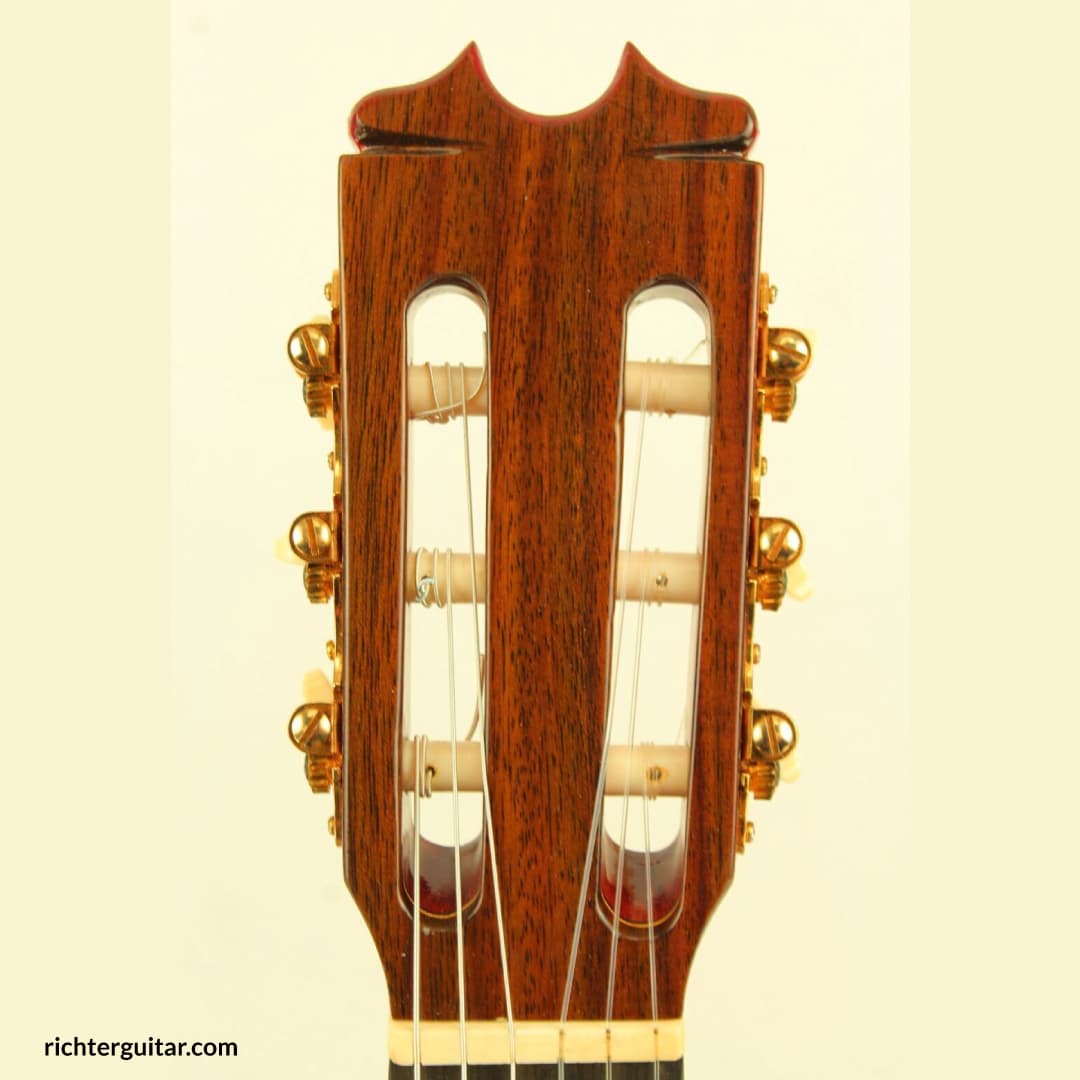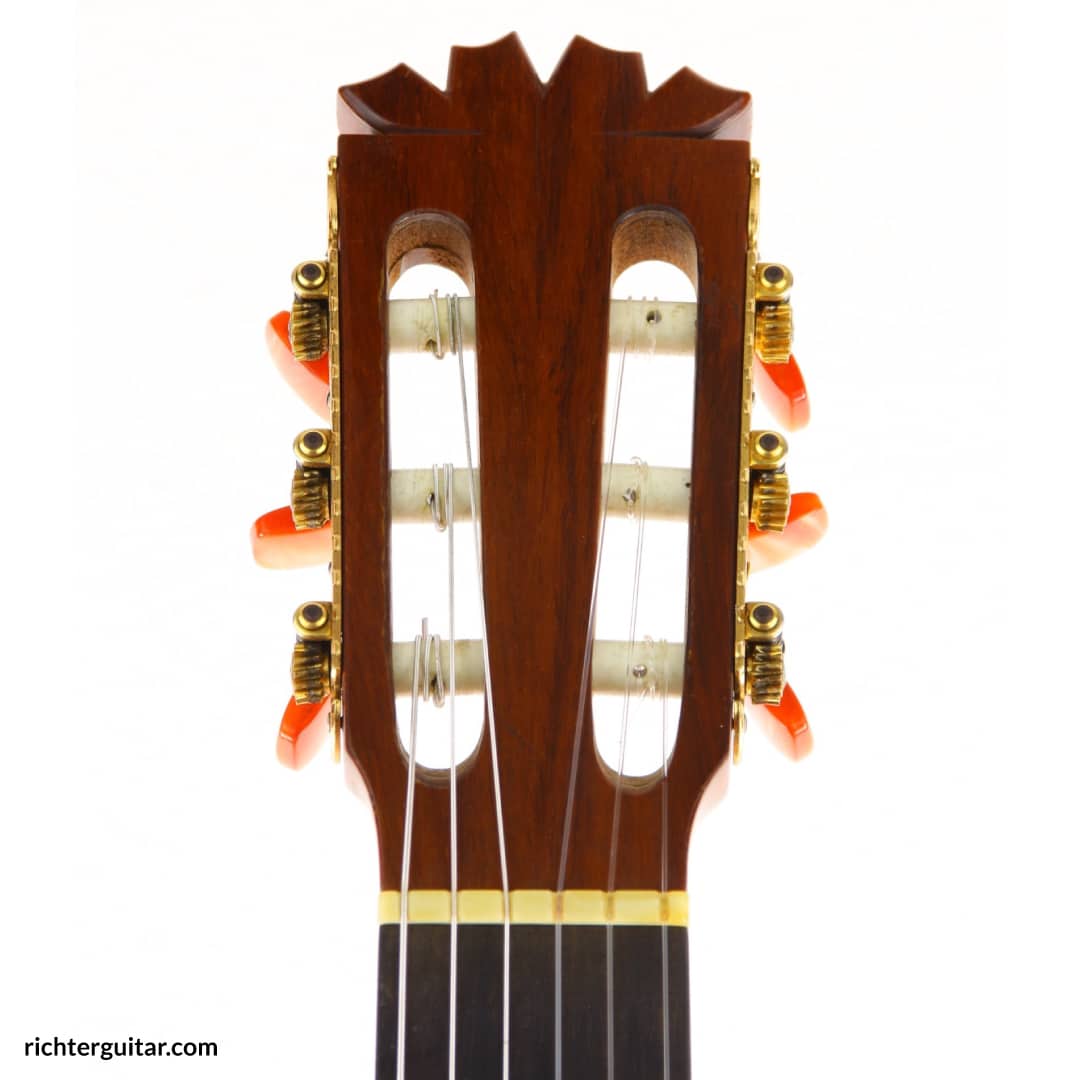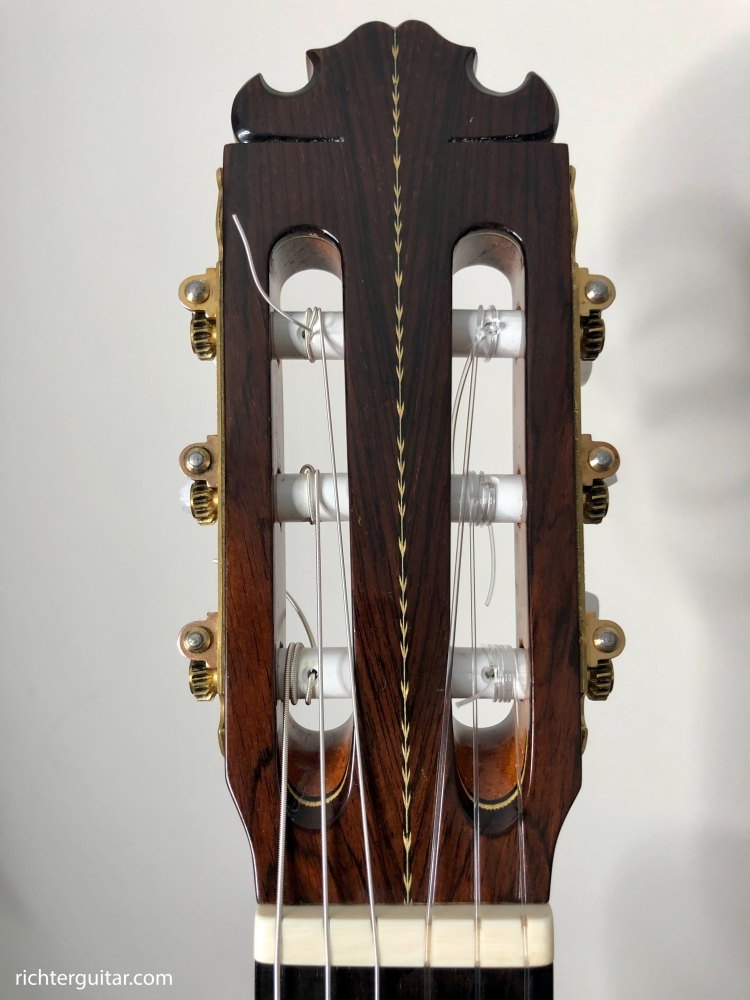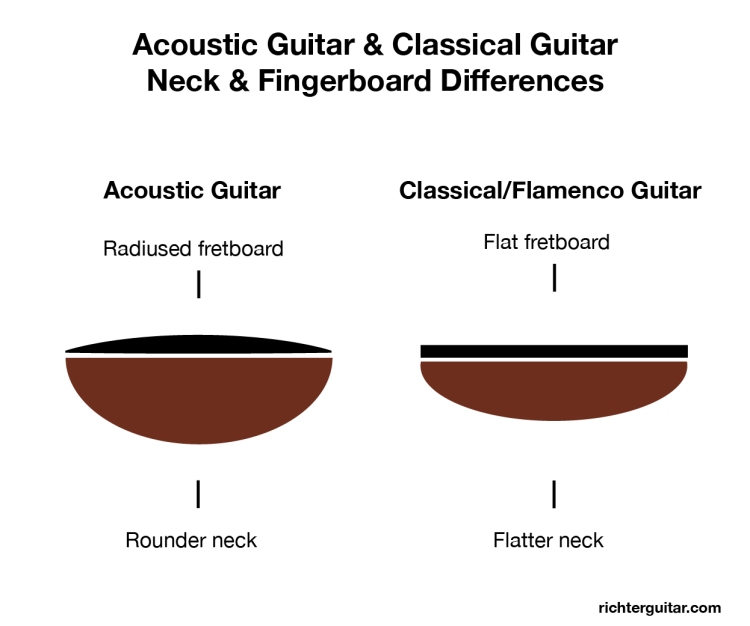Parts of the Classical Guitar:
What are the parts of the classical guitar?
If you’re learning classical guitar, you may be asking yourself “what are all these different parts of the guitar?”. Rest assured, each acoustic guitar part is easy to find and identify!
Guitar makers use intricate interior and exterior construction methods and designs to build their instruments. This article will help you learn more about the important exterior parts of the guitar anatomy.
At a high level, we can categorize the into three main sections: the head, the neck, and the body. Each section serves an important function that contributes to the overall construction and sound of the guitar.
With beautiful designs, craftsmanship, and tonal considerations, these parts all play a role in forming a guitar’s unique ‘personality’.
Only interested in learning the most important parts of the guitar? The top 5 must-know parts are: tuners, the fingerboard, frets, strings, and the sound hole.
Diagram – classical guitar parts
Here’s a diagram of a standard six string classical guitar:
As you can see from the guitar parts diagram above, the head, neck, and body of the guitar have many more sub-parts. The rest of this article will cover each these parts in more detail.
Let’s start at the top!
1. Head/Headstock
The guitar head, also called the headstock, is one of the most unique and identifiable parts of the guitar. Classical guitar strings are attached to the head by threading through the tuning pegs (string rollers).
Tuners (machine heads) are also located on the head to tighten or loosen each string, which can raise or lower the pitch.
Luthiers (guitar makers) will often include fancy inlays, a characteristic headstock shape, and/or attractive woods that compliment the back and side wood tones.
In fact, sometimes you can tell which luthier made the guitar just by seeing the headstock! Two well-known examples of signature headstocks include the Felix Mazanero “M” shape, and the Hermanos Conde “Media Luna” (see below).


Tuners (Machine Heads)

The guitar tuners are geared mechanisms that adjust the pitch of the strings. Other names for guitar tuners include: machine heads, tuning pegs, tuning machines, tuning keys, or gear heads.
Modern machine heads are found on the sides of the guitar head, and are usually a series of 3 in-line. As you can see, three plastic tuner heads called buttons are attached to gears on onto a single metal plate. Classical guitar tuners usually come in sizes of 11cm*5cm*4cm.
String Rollers
Classical guitar string rollers are attached to the tuners, and go through the headstock of the guitar. Each roller has a hole where the guitar string runs through it. As you turn a machine head to tighten a string, the guitar string wraps around the string roller.
2. Neck
The neck is one of the most important parts of the classical guitar. The neck is where guitarists place their left hand fingers to manipulate the tension (and therefore, the pitch) of the strings.
Considerations like neck width, scale length, number of frets, and shape can have serious implications for players.
Most standard classical guitar necks have the following dimensions and characteristics:
- Width: 52mm (measured at the nut)
- Scale Length: 650mm (calculated by measuring the distance between the end of the nut and the center of the 12th fret, then doubling that measurement)
- Number of Frets: 19
- Neck wood: Mahogany or Spanish cedar
- Fingerboard wood: Ebony
- Neck connects to the body at the 12th fret
The dimensions listed above are only the most common standard measurements. For instance, nut widths can vary from 48mm-54mm or more. Similarly, scale lengths may vary from 635-664mm or more.
It’s also important to note that classical guitar necks taper towards the body of the guitar. This means that the width of the neck increases, even though the space between frets decreases. Due to this variance, people calculate the guitar neck width at the nut.
As the neck gets wider towards the body of the guitar, more vertical space occurs between the strings. This increased width between the strings means you might needs to adjust your left hand fingers slightly to land on the strings properly (especially true for making barre chords in upper positions). However, the increased space between the strings also means that your right hand fingers have more room for plucking.
Nut
The guitar nut is a small piece of bone, plastic, or melamine material that supports the strings near the headstock. This is similar to the saddle on the body of the guitar.The classical guitar nut has small grooves where the strings are aligned and secured.
If you want to adjust the action of your guitar strings, you can do so partially by adjusting the nut. All in all, adjusting the action at the neck is a fairly simple procedure. However, unless you have a lot of experience already you’ll want a professional to help do an expert job.
As mentioned in the previous section, the nut is also important because this is where the classical guitar neck width is measured. You can learn more about the guitar nut and width considerations here.
Note: On most high-end classical guitars, the nut and the saddle aren’t glued in place. When you’re changing strings, watch carefully to make sure they don’t slide around or get misaligned.
Fingerboard/Fretboard
The classical guitar fingerboard, also called fretboard, is the area of the neck where frets and strings are located. The fingerboard is where you place your left hand fingers to change the pitch of the strings.
Flat vs Radiused
Most classical guitar fingerboards are flat, though some fusion or crossover guitars have a radiused fingerboard. As you can see in the diagram below, radiused fingerboards are more common on steel string acoustic guitars:
Standard vs Elevated
Most fingerboards run parallel to soundboard, and therefore only provide several millimeters of clearance above the soundboard.
However, luthiers are continuing to innovate with a construction technique go overcome this playing challenge, known as the elevated fretboard (also called raised fretboard). The purpose of elevated fretboards is to make it easier for guitarists to reach beyond the 12th fret. Some luthiers claim that the elevated fingerboard also provides superior tone, resonance, and sustain.
Frets
On a classical guitar, frets are the thin nickle-steel (or stainless steel) slabs that indicate where your fingers should land on the fingerboard to produce a note. Each fret represents a half step of distance between notes.
Most classical guitars have a total of 19 frets, although some luthiers are making some models with 20 frets. The guitar neck typically connects with the body of the guitar at the 12th fret (the octave mark). Therefore, you can expect to play most music within the first twelve frets where the notes are easiest to play.
If you’re a beginner guitarist, I recommend you get comfortable playing on frets 1-5 before worrying about the upper positions. If this range feels too wide for you, you can experiment with stretching exercises further up the neck. Another tip I recommend is to practice using a capo so there’s less spacing between frets!
Classical guitar frets have a slight curve, and are typically wider than steel string acoustic and electric guitar frets. Standard frets have a crown size of 0.080 x 0.037″ (2.03mm x .94mm), and are cut from classical guitar fretwire.
For more specific info on frets and fret wear, check out this article.
Guitar Strings


Although they’re not part of the permanent guitar construction, strings are certainly an important component of the classical guitar!
Just like electric or steel string acoustic guitars, standard classical guitars have six strings. However, there are some classical models that have seven, eight, or twelve strings. From low pitch to high pitch, the strings are tuned: E, A, D, G, B E. You can learn more about hot to tune your guitar here.
Prior to the introduction of nylon guitar strings in 1947 by Albert Augustine Strings, ‘gut’ or ‘catgut’ was the most commonly used string material. Since then, standard classical guitars have almost exclusively been made of nylon. This includes the bass strings, which are nylon wound with copper wire.
Classical guitar strings are secured at the head of the guitar on the tuners (string rollers) and tied below the sound hole at the bridge. For more tips on how to string your classical guitar, check out my related article here.
String Brands
There are many brands of classical guitar strings on the market today. Several of the most widely used brands are: Augustine, D’Addario, Hannahbach, Knobloch, and Savarez. For a comprehensive list of other string brands, check out Strings By Mail.
People primarily categorize nylon classical guitar strings by tension. The most common styles are: normal tension, hard tension, and extra hard tension.
I like using a combination of D’Addario EJ46 Hard Tension for the bass strings, and Augustine Regal Blues for the treble strings. However, string brand and tension is a personal choice and matter of preference. I recommend you experiment until you find a brand that feels and sounds right for you and your guitar!
Heel (Spanish Heel)
Some classical guitars have what’s called the “Spanish heel”. This name comes from a distinctive construction style developed by Antonio Torres (1817-1892) in Spain. The Spanish heel is made when part of the guitar neck remains inside the body while building the guitar.
The heel is a more complicated and delicate construction process compared to cheaper models. With cheaper guitar models, the necks are completely separated and glued on later. Therefore, guitar necks built using the Spanish heel technique are typically more stable and durable than those without it.
For more specific details on the Spanish heel construction, check out this article.
3. Body of the guitar
The classical guitar body is the largest part of the instrument. From a construction, tone, and sound production standpoint, it’s also the most complex part with the greatest degree of variance. In order for the guitar to produce a rich and full tone, the top, back, and sides all require precise measurement, wood selection, and attention to detail.
Classical guitars have an extensive family tree going back to the Spanish vihuela and gittern of the 15th and 16th centuries. The top part the body is the upper bout, and the larger and wider part below is the lower bout.
Today, ‘modern classical guitars’ are ones that follow the innovative and revolutionary designs of the 19th-century Spanish luthier Antonio Torres. All modern guitar models built today (classical and acoustic) are derived from the Torres models.
But people didn’t just stop creating new designs when the Torres model appeared. Now, luthiers are continuing to come up with innovative methods in an attempt to increase the natural volume and projection of the classical guitar.
Classical guitar luthiers such as Manuel Contreras, Jose Ramirez, Robert Ruck, and Mathias Dammann led such innovation in the 20th century. They invented innovative techniques such as double tops, side monitor sound holes, resonators, and other unique construction styles and methodologies.
Soundboard – Top of the Guitar
Most people consider the soundboard to be the most important piece of wood that affects the tone of the classical guitar.
Some of the most renowned luthiers will carefully source the wood they use for the soundboard. In fact, some guitar makers will even keep reserves of the highest quality stock for twenty or more years before using it on an instrument.
The wood used for the top, back, and sides is also referred to as the “tonewood”. More often than not, the wood used for the soundboard will be different from the wood used for the back and sides of the guitar.
Spruce vs. Cedar
The most common classical guitar soundboard tonewoods are cedar and spruce. Why are these the most common tonewoods? The simple answer is: history and functionality.
Historically, spruce has been the tonewood of choice for centuries. Compare this with cedar tops, which has only been used since the early 1960s.
Functionally, due to the tension of the strings the soundboard needs to be flexible, yet durable. Both spruce and cedar check these boxes, making it an excellent wood to use as the soundboard.
The spruce vs cedar debate is a rather humorous one, as you will find countless forums and articles describing the pros and cons of using over another. Most classical guitarists do have a preference for either spruce or cedar. I personally own both cedar and spruce top guitars, and love the sound of both!
Although not used as often as spruce and cedar, alternative soundboard tonewoods include:
- Alerce
- Bunya
- Fir
- Hemlock
- Koa
- Mahogany
- Maple
- Pine
- Redwood
Sound Hole
On acoustic instruments, the sound hole helps with amplification. The sound hole is located on the soundboard (top) of a classical or acoustic guitar.
If acoustic guitars didn’t have a sound hole to allow the internal resonance to release, the sound would be trapped in the body. The result? Sound wouldn’t be able to project as loudly or clearly.
Sound production and natural amplification of the classical guitar is something luthiers are continuing to experiment with. One such innovation is the side monitor sound holes, which is an additional sound hole located on the upper side of the guitar body (nearest to the 6th string).
Rosette
On classical guitars, a rosette is the artistic design that surrounds the sound hole. Historically, the rosette was used to prevent wood cracking near the sound hole. Today, the rosette is primarily decorative.
Aside from the natural beauty of the guitar wood itself, most people agree that rosettes are one of the most beautiful and distinctive parts of a classical guitar. Some of the world-class luthiers create their own rosettes, while others may purchase pre-made ones.
Elaborate guitar designs will take careful consideration of the rosette pattern, and may add additional inlays around the soundboard, bridge, back, or sides of the guitar that match the style.
Bridge
The guitar bridge is located below the sound hole, and is where the strings connect to the soundboard. The bridge has of several sub-parts, including the bridge base, bridge, saddle slot, and saddle.
To learn how to tie and secure classical guitar strings to the bridge, check out my article here.
Saddle
The classical guitar saddle is located on the bridge. Similar to the nut, the saddle is usually made of bone, plastic, or melamine material.
The strings sit on top of the saddle in order to provide some additional leverage. The saddle also ensures that the strings are aligned properly.
You can adjust both the saddle and the nut to lower the guitar action. Even though adjusting the saddle and nut isn’t overly complicated, it’s still a smart idea to have a professional luthier take care of it. They have the proper tools and knowledge to ensure that your guitar setup is accurately to sound it’s best!
Note: On most high-end classical guitars, the nut and the saddle aren’t glued in place. When you’re changing strings, watch carefully to make sure they don’t slide around or get misaligned.
Back & Sides
Second only to the soundboard, the wood used for the back and sides also plays a crucial role in a guitar’s tone quality, resonance, and projection. Luthiers will almost always use the same wood for both the back and the sides, and try to apply a matching set whenever possible.
Rosewoods
Most people consider Brazilian rosewood (“Central [or] South American Rosewood [CSAR]”) the best quality tonewood to use for the back and sides of a classical guitar. Brazilian rosewood has a rich, dark reddish-brown color that is simply stunning.
However, Brazilian rosewood is getting increasingly more scarce, expensive, and regulated. As a result, Indian rosewood (IRW) has become a popular substitute with comparable sound quality.
African blackwood (AB) is the densest rosewood, and considered another top-tier quality tonewood. Although African blackwood is also rare, it’s quickly becoming a popular and highly coveted choice for guitar makers worldwide.
Other rosewoods used for the back and sides include: African rosewood (different from African blackwood), Honduran rosewood, palo rosa (pink rosewood),
Maple, Cypress, and More
Lighter and brighter tonewoods, such as maple and cypress are also commonly used for the back and sides. Antonio Torres used maple back and sides on his most renowned instruments. As a result, this has become a popular go-to choice of wood. The sound of a guitar with maple back and sides is warm, bright, and resonant.
Many flamenco guitars in the early 20th century were built using cypress back and sides, since it was cheaper to source at the time. Together with a quality spruce top, guitars with cypress back and sides have a quick attack, and can project a bright and spectacular response. This tonewood combination was so prominent, it’s practically synonymous with the distinctive “old school flamenco guitar” sound!
Similar to soundboard tonewoods, guitar makers are continuing to innovate and experiment with different types of wood for the back and sides.
Here’s a list of alternative tonewoods used for the back and sides:
- African blackwood
- African ebony
- African rosewood
- Ash
- Black limba
- Bocote
- Bolivian rosewood
- Brazilian lacewood
- Caviuna
- Cherry
- Cocobolo
- Eucalyptus
- Exotic ebony
- Fruitwood
- Granadillo
- Green ebony
- Grumixava
- Honduran mahogany
- Honduran rosewood
- Imbuia
- Kamagong
- Kingwood
- Koa
- Makassar ebony
- Mahagony
- Malaysian blackwood
- Mango
- Ovangkol
- Padauk
- Palo escrito
- Palo rosa (pink rosewood)
- Pau ferro
- Pear
- Sapele
- Satinwood
- Sycamore
- Tigerwood
- Tulipwood
- Uruguayan blackwood
- Walnut
- Wenge
- Yew
- Ziricote
Conclusion
After reading this article, you should feel more confident in understanding the various parts of your classical guitar!
My goal in writing this article was to present a solid overview of the various exterior parts of the classical guitar anatomy. However, there’s many more interior parts of the classical guitar that are intricate, complex, and innovative.
Want to learn more about guitar construction and luthiers? Check out this site.
I hope you found this article to be helpful, informative, and insightful! Please share this article, and subscribe to my newsletter for more free content!
Thanks for reading and happy playing!












